Did the Nazi leader fake his own death and escape to South America? Hunting Hitler investigators make a compelling case
The first time I had heard of the documentary series Hunting Hitler was during one of my excursions back to the homeland. I had landed late and was the only passenger in the airport shuttle bus, so the driver took the opportunity to chat away at me. I knew the question was coming, but was tired from the flight and reluctant to give him any more ammunition. Finally, I relented: “I’m from here, but I live in Colombia.”
And with that, he set upon explaining the details of a historical TV show he was binge-watching on his days off and how convincing it was. To my surprise, the anecdote he proceeded to tell was pretty good. As a closet history nerd with a fascination for all things WWII, I listened intently. As the story goes, Nazi leader Adolf Hitler did not kill himself in his Berlin bunker as Russian forces besieged the city in 1945. He in fact escaped, and secretly spent the rest of his life in South America. A team of investigators tracked Hitler to Argentina, my driver explained, and then on to the place I call home – Bogota, Colombia.
Upon hearing this, I let out a chuckle, and the driver – sensing my disbelief – implored me to keep an open mind and watch the show for myself. After a couple days back home, boredom set in, so I Googled and found the TV series on the History Channel called ‘Hunting Hitler’.
Much to my surprise yet again, the series is not some rumor-driven wild goose chase carried out by a bunch of wide-eyed conspiracy theorists. The group of investigators was made up of ex-CIA and US Army Special Forces, US Marshals and investigative journalists. The research, and the documentary series that it spawned, is based on WWII-era intelligence reports and testimonies made during the Nuremberg Trials.
Hunting Hitler in South America
In 2014, the US Federal Bureau of Investigations (FBI) released 700 pages of declassified documents to the public that revealed various branches of the US government were investigating the whereabouts of Hitler years after he was thought dead. Two of the investigators pour over the files, while others do the leg-work, traversing three continents following up on dozens of Hitler sightings, principally in remote corners of Argentina, leading them to country estates, hidden and inaccessible compounds, bunkers, underground tunnel networks and other clandestine facilities. My skepticism began to erode.
Could what is thought to be common knowledge – that Hitler and his wife Eva Braun committed suicide in their underground bunker – be wrong?
For decades, two main sources have been used to determine that Hitler committed suicide. The first relies on testimonies from members of Hitler’s inner circle, who all claimed that Hitler and Eva Braun took poison, and then Hitler shot himself, before their bodies were wrapped in blankets, carried out of the bunker and burned. The second comes from reports from the Soviet troops who stormed Hitler’s bunker and controlled the scene, along with all the forensic evidence. On the 2nd of May, 1945, Soviet troops searched the bunker and eventually shipped Hitler’s supposed remains to Moscow.
The world may have breathed a sigh of relief upon hearing of Hitler’s death, but leaders of the Allied powers never seemed to have bought the official version of events.
In August, 1945, while the two were at the Potsdam Conference in occupied Germany, US President Harry Truman asked Joseph Stalin whether Hitler was dead. ‘Uncle Joe’ is said to have replied bluntly, “No.” And as late as the 1950s, US President Dwight D. Eisenhower declared: “We have been unable to unearth one bit of tangible evidence of Hitler’s death.”
One of first files the Hunting Hitler team examines, dated May 8, 1947, and addressed to FBI Director J. Edgar Hoover states that: “American Army officials in Germany have not located Hitler’s body, nor is there any reliable source who will say definitely that Hitler is dead.”
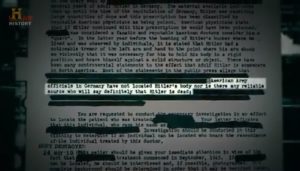
Interviews with members of Hitler’s inner circle said they saw the bodies of what they were told were Hitler and Eva Braun, but they could not say definitively that it was in fact the body of the German leader and his wife because they were burned beyond recognition.
Modern forensics also casts doubt on the official story. In 2009, a team of American scientists were given access to a human skull the Russians claimed for decades was that of Hitler – considered the most definitive evidence that he committed suicide in his Berlin bunker in 1945. But DNA analysis revealed that the remains belonged to an unknown female, therefore the skull could not be Hitler’s.
Did the leader of the Third Reich fake his own death to cover up a well-organized escape plan? The team of Hunting Hitler investigators thinks so, as did much of the US intelligence community, and they devoted manpower and resources to set out to find him and other high-ranking Nazi officials.
Much of what is in the treasure-trove of FBI documents is corroborated by the investigative team. They contend that Hitler could have made it out of the bunker, escaped through Spain and the Canary Islands, and travelled by U-boat to Argentina, where he would have refuge among a vast network of Nazi party members and sympathizers. The case they make is compelling, and only the most cynical historian would dismiss the theory outright without considering the evidence.
After the war, thousands of Nazi war criminals fled to South America, the majority of those opting to start anew in Argentina. The declassified documents indicate that on Sept. 21, 1945, the Fuhrer himself arrived by U-boat in the South American country, where a vast and covert transport, security and accommodations network befitting the Nazi leader was waiting.
Hitler Sightings in Colombia
As the story goes, Hitler would not be content to live out his days in anonymity. Some reports have him moving north, as far as Bogota, and ostensibly to the Colombian town of Tunja.
The theory that Hitler came to Colombia in the late 1940s or early 1950s has grabbed the attention of the Colombian and international press sporadically over the years, going as far back as the 1960s. The idea gained renewed interest with the release of a book called Colombia Nazi, written by two Colombian academics and published in 1986, and then again in 2013, with the publication of Grey Wolf, perhaps the most important work on the subject of Hitler secretly residing in South America after the war.
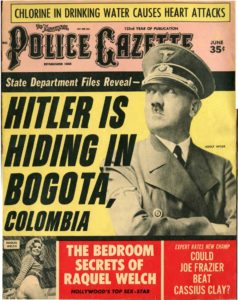
Cover of the June, 1968 edition of the US men’s tabloid magazine Police Gazette, claiming that ‘Hitler is hiding in Bogota, Colombia.’
Some in the Colombian media, too, should be credited with correctly deeming newsworthy the notion that one of the most bloodthirsty dictators of the 20th century may have graced their land, and is worth a few column inches. The Hitler-in-Tunja story first gained traction in 2014 – and then again, just this week – with the release of a recently-declassified CIA document made public as part of a trove of US government files related to the JFK assassination.
That document, treated with much fanfare here in Colombia, allegedly places Hitler in Tunja, Boyaca, in February 1954. But the sighting is no smoking gun. It is clear from the report that the CIA was doubtful about the claims, but nonetheless had to follow up. “Because of … the apparent fantasy of the report, the information was not submitted at the time it was received,” the intelligence file states.
Earlier this year, Argentine journalist and author Abel Basti, who has spent much of his career pursuing rumors of the Fuhrer’s supposed movements in his home country, said in an interview that he too believes that the leader of the Nazis came to Colombia in 1954. His findings are laid out in his latest book Los Secretos de Hitler (Hitler’s Secrets), which Basti presented at the Bogota International Book Fair (Filbo) in May this year.
Author Abel Basti gives an interview with Colombian media in June this year after a large cache of Nazi artifacts were discovered in Buenos Aires. During the interview, Basti speaks of the time Hitler allegedly spent in Colombia.
Hitler Wasn’t Here for Tourism
Among the thousands of FBI documents declassified in 2014, the Hunting Hitler researchers cite one dated May 22, 1948, that places Hitler in Bogota. “Hitler, two German physicists and two pilots travelled by plane,” the document states. “They carried with them secret plans for the V-3 Sky Rocket bomb.” It suggests that Hitler, while defeated in Europe, may have been pursuing the aim of carrying on the war in the Americas, with plans for a surprise attack on the United States.
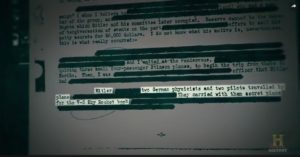
Above: Screen grab of a declassified US intelligence document stating that Hitler flew to Bogota with ‘secret plans for the V-3 Sky Rocket bomb.’ Below: A similar document that claims an aircraft carrying Adolf Hitler landed in the La Florida district of Bogota, Colombia, in 1948.
In 1939, Nazi Germany launched a secret project to develop nuclear weapons. The scientists assigned to this project were some of the most skilled in the world, with thousands of them ultimately being recruited by the US to work on American nuclear programs after the war. They also developed two types of rockets, one of them being the V-3, which was said to have a range of thousands of miles, something that was unprecedented at the time.
“Look at Colombia. A V-3, from the designs we know, could go the 2,000 miles and hit the United States in some sort of ‘Hail Mary’ attack. Is it fantastic, yeah, but this is Adolf Hitler, and his plan … is to strike the main enemy, the United States,” lead investigator Bob Baer, a 21-year CIA veteran, stated at one point in the series. “It was the United States which brought down the Third Reich. And only once the United States was brought down, could the Fourth Reich come.”
The theory goes that Hitler’s ultimate goal was to take revenge against the country that was instrumental in bringing down the Third Reich with a surprise nuclear assault. So why did the Nazi leader choose Colombia and not Venezuela or a Central American country also close enough to hit the US with a nuke-tipped missile? Perhaps he saw chaos as an opportunity. At the time, the country was in the throes of La Violencia and the Bogotazo riots that came after the assassination of Liberal Party leader Jorge Eliécer Gaitán on April 9, 1948. If the FBI files are correct, Hitler would arrive in the country just six weeks later.
The Search is On
In the episode that focuses on Bogota, the team of investigators pinpoint the marsh mentioned in the FBI report as the Santa Maria del Lago marsh at the end of Calle 68, in the west end of the city. They seize on an old rumor that there was a plane at the bottom of the lake, and the team set out to scan the marsh with state-of-the-art sonar equipment that can create real-time high-resolution images of objects at the bottom of the muddy, silt-filled marsh.

Investigators Regan Lipinski, center, and Tim Kennedy, right, begin their search of Santa Maria del Lago Marsh, looking for signs of plane wreckage with high-tech sonar equipment.
Hitler would not have travelled to a country unless there was pre-existing Nazi infrastructure in place that would provide support, intelligence and logistics, and at the time, one such organization did exist in Colombia that could have filled those roles – SCADTA, or the Colombian-German Air Transport Society. The society was formed in 1919 by a group of German pilots who moved to Colombia after serving in WWI. It was established to help move goods and people across the country’s vast, roadless and rugged countryside. The airline grew to become the second largest in the world at the time, and the first in the Americas.
One of SCADTA’s members, a German immigrant by the name of Herbert Von Boy, was accused of being a Nazi, and probably for good reason. As investigators discover, Von Boy was from the same region, and was a schoolboy chum of none other than Nazi Propaganda Minister Joseph Goebbels.
In the 1940s, Colombia formally sided with the Allied powers, and, at the behest of the US, began rounding up suspected Nazi supporters and sympathizers, with a particular focus on German communities in Bogota and elsewhere. The government seized SCADTA, arrested suspected Nazis, most of whom were deported. After the now-government-controlled airline merged with a smaller company, the airline was renamed to a carrier we all know and love today: Avianca.
Researchers also discovered that a large swath of property in and around Santa Maria del Lago was in those days owned by the family of Alfonso Lopez Pumarejo, Colombia’s 16th president. They surmise that the marshland could not possibly be the landing site of Hitler’s plane, as they wouldn’t dare land on the property of the president in a country where they’re rounding up all suspected Nazis; they’d be landing in a trap. The team find another marshland closer to Bogota’s El Dorado International airport and assume that’s what the intelligence report must have meant. But after combing over that lake with their sonar equipment, they come up empty handed.
Investigators Made a Mistake
The calling off of the search of Santa Maria del Lago irreversibly changed the course of the investigation, and was based on one crucial fact that both investigators and their local fixer got wrong. They were working under the assumption that Hitler’s plane wouldn’t have landed on then-Colombian President Pumarejo’s property. But Pumarejo, who was also a member of the Liberal Party, was in office from 1942 to 1945, meaning he was not the president of Colombia during Hitler’s presumed arrival in 1948. Another man, Mariano Ospina Perez, a Conservative Party member, was occupying Colombia’s top office by then.
Colombia’s liberals and conservatives were bitter rivals, and the tension between them was a powder keg ready to explode – and it did in 1948 with the assassination of Gaitan, triggering La Violencia. It could be argued that the advent of this sectarian violence and the chaos that ensued meant that dumping a plane in the Santa Maria marsh would not be as illogical as the team presumed.
It’s a shame the team prematurely called off the search of the Santa Maria del Lago. (It’s also a shame that we here at MiKo are not in possession of high-tech sonar equipment and a boat; we could do the search ourselves!) It’s too bad they didn’t do their homework. If they had, they would have realized that the very lake where Hitler was supposed to have landed was not owned by the head of state, but the former president, who had resigned before his term was up after narrowly surviving a failed military coup.
With that knowledge, they might have thought it worth the effort to finish their search of the marsh – at the very least to dispel local legend about the remains of a submerged plane – and by the fact that a thorough and professional investigation demands that no stone be left unturned.
***
Unanswered Questions
1. If Hitler survived, successfully made it to South America and began preparations for a Fourth Reich, what was he waiting for? He would have had 15 years to bring his plan to fruition (he is presumed to have arrived in 1947, and by some accounts, died in Patagonia in 1962, at the age of 73).
2. The ‘Hunting Hitler’ team puts Hitler in Bogota, Colombia in 1948, but author Abel Basti’s account places him in Tunja, Boyaca, in 1954. Does that mean Hitler was in Colombia for at least six years?
3. The authors of the FBI report who put Hitler in Bogota in 1948 obviously did not know the city well. The La Florida Park and the Santa Maria del Lago are nowhere near each other. La Florida is just outside the city limits, more than 14km away from the marsh. How could professional G-men make such a geographical blunder?
We may never know the answers to these questions, as we may never find conclusive proof that Hitler actually made it to the South American continent. As much evidence as there is for the presence of thousands of other Nazi war criminals here – for Hitler, there is really only the hearsay of now elderly descendants of alleged eye-witnesses. Further still, there are enough holes, doubts, and contradictory timelines in the declassified files that the legitimacy of the entire work could be called into question. All the dead-ends, half-answers and fragments of proof might just be what you get when you dig too deeply into the past. But maybe it’s not digging that’s needed – maybe it’s diving – down into the depths of the Santa Maria marsh.
If you are in possession of high-tech sonar equipment and a boat and would be willing to lend it out to MiKo, please contact us. We would love to be the ones to find plane wreckage at the bottom of Santa Maria del Lago.

Journalist. Misfit. Malcontent. Provocateur. Is a better Colombia is possible? We’re starting to have doubts.

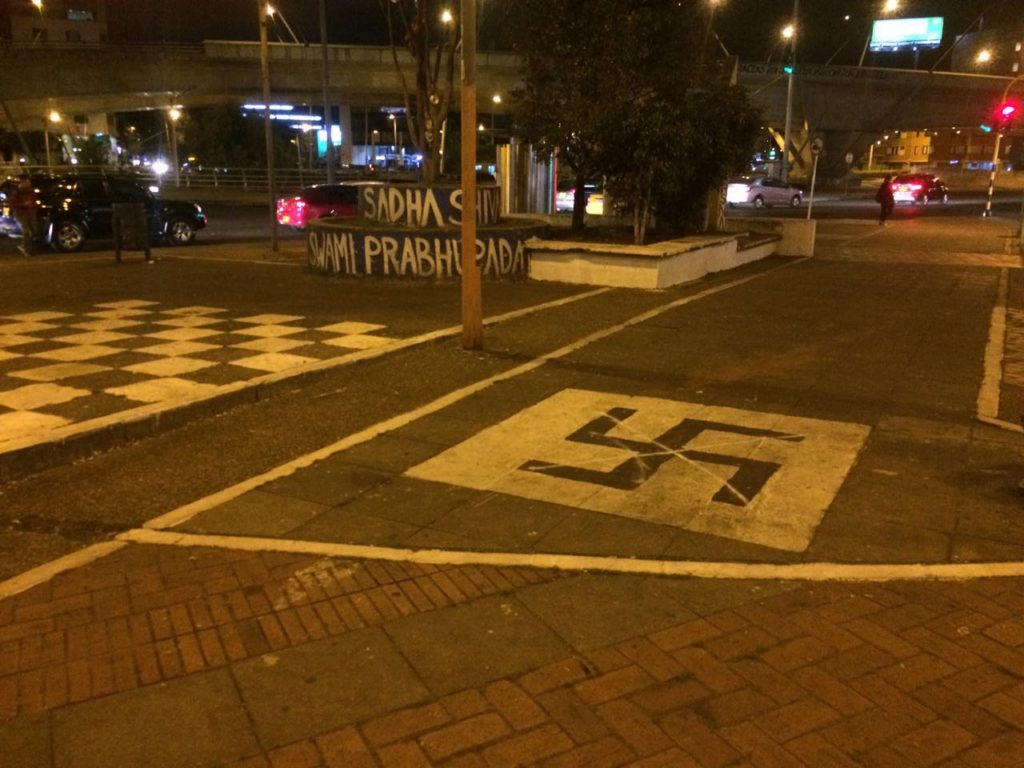
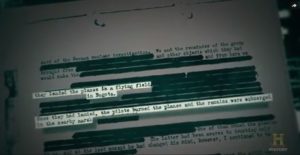
Soon we´ll hear of Hugo Chavez sightings in the Bolivarian Republic.
But the journalists need sensational stories to gain audience for their publications. How else will they become rich and famous?
That is unreliable given the huge vested interest that all the major powers would have had in asserting Hitler was dead. Both the US and Russia could have simply coordinated this while holding all parties in custody. At that point, all though there existed tensions between both powers, it was in their mutual interest to make sure that the Nazi figure head was permanently removed from the picture.
He died in Berlin. Hitler’s dentist was captured after the war by the Americans. Two of his dental techs were captured by the Russians. Each independently reconstructed the details of Hitler’s dental work from memory. Their reconstructions meshed completely, and they fit with the details of the dental work on the jaw fragments attributed to Hitler AND to the skull X-rays taken of him by his doctor after the July 20 bomb attempt. Bottom line, there is solid forensic proof beyond a reasonable doubt that Hitler died in Berlin. For a detailed account of the forensic exam go to http://www.nl-aid.org/wp-content/uploads/2012/09/Sognnaes.pdf .